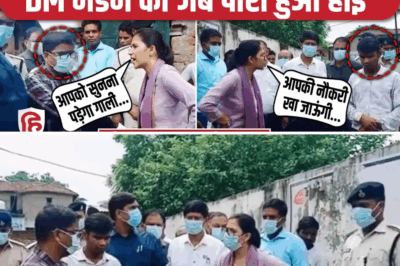Battling the Deluge: Flood Crisis in Uttar Pradesh, Rajasthan, and Madhya Pradesh Leaves Thousands Homeless”

India’s Heartland Drowns: Floods Wreak Havoc Across Multiple States
As the rains refuse to cease, a humanitarian crisis has unfolded across vast stretches of north and central India. The relentless downpour has turned tranquil rivers into raging torrents, flooding entire villages, devastating crops, and forcing thousands to leave their homes in search of safety.
Uttar Pradesh Under Water
Seventeen districts in Uttar Pradesh (UP) are facing one of their worst flood crises in years. Over 400 villages, especially those nestled along the banks of the Ganga and Yamuna, are almost entirely submerged. The floodwaters have destroyed thousands of hectares of standing crops, adding to the woes of farmers and threatening food security in the region.
Key districts like Prayagraj, Varanasi, Mirzapur, Kanpur, Banda, and Hamirpur are among the hardest hit. For many, the disaster has reached their doorsteps — literally. Streets once bustling with vehicles are now accessible only by boats. Relief camps have sprung up in affected cities, offering temporary shelter, but the scenes are heart-wrenching. Residents are seen carrying their livestock and belongings, wading through waist-deep waters to escape the rising tide.
Prayagraj is reeling the most. Both Ganga and Yamuna rivers have breached danger levels, flooding over 60 municipal wards. Nearly 14 relief camps are now sheltering hundreds of families. Homes, offices, and local businesses are inundated. Key cremation ghats like Manikarnika and Harishchandra are underwater, forcing grieving families to wait for boats to conduct final rites. Disturbingly, even the famous Hanuman temple now has water lapping at its sanctum, forcing authorities to seal its doors.
Residents complain of delayed administrative action, highlighting a growing sense of abandonment after days of power, water shortages, and lack of basic supplies. Despite assurances from state authorities and even inquiries from Prime Minister Narendra Modi, many citizens claim government relief efforts are yet to reach them.
Rajasthan: Drowned Deserts
The desert state of Rajasthan, often synonymous with drought, now faces the opposite challenge — too much water. Districts like Tonk, Sirohi, and Dholpur have seen record rainfall. The swelling Banas River has led to tragic incidents, including people being swept away by the current and tourist buses losing control on algae-slicked roads. In Dholpur, incessant rain has rendered thousands homeless, and fields of standing crops lie ruined, leaving cattle without fodder and pushing farmers to the brink of despair.
Madhya Pradesh: Nature’s Fury Unleashed
In Madhya Pradesh, the situation is equally grim. Ashoknagar and Chhindwara districts have reported significant devastation, with entire villages submerged and crops wiped out. In a heroic act, local police rescued a 70-year-old woman swept away by the current near Chhindwara’s Pench dam, underscoring the scale of human suffering and the efforts of first responders. Even urban areas are not safe. In Mandsaur, people were shocked to see a crocodile on city streets, flushed out from its habitat by floodwaters.

A Relentless Ordeal
As meteorological forecasts predict more rain, hopes for immediate respite are dim. Rapidly rising river levels are being closely monitored by local and central authorities, but the magnitude of the crisis is pushing resources to their limits.
Every day brings new challenges — from families relocating in makeshift boats to farmers watching their year’s toil disappear underwater. For many, the last straw is the lack of compensation and help, leading to mounting frustration.
Conclusion: A Call for Action
The ongoing flood crisis across UP, Rajasthan, and Madhya Pradesh is a stark reminder of nature’s unpredictability and the urgent need for disaster readiness in India’s most populous states. Relief operations are underway, but for countless families, the journey to safety—both physical and financial—will be long and fraught with uncertainty. As the waters rise, so does the call for robust infrastructure, better planning, and compassionate governance to weather such storms in the future.
News
Sanjay Kapoor Death Mystery Deepens: Mother Demands UK Probe Amidst Billion-Dollar Inheritance Battle”
Sanjay Kapoor Death Mystery Deepens: Mother Demands UK Probe Amidst Billion-Dollar Inheritance Battle The bitter dispute over Sanjay Kapoor’s vast…
Billion-Dollar Battle: Inside the Sh0cking Succession Drama After Sanjay Kapoor’s Death”
Billion-Dollar Battle: Inside the Shocking Succession Drama After Sanjay Kapoor’s Death A high-stakes inheritance war has gripped the legacy of…
America’s Most Haunted Doll Has a New Owner—and It’s a Name You Know!
America’s Most Haunted Doll Has a New Owner—and It’s a Name You Know! The infamous Raggedy Ann doll—known to horror…
RIP Dharmendra!!? The Truth Behind Viral Rumors and His Health Condition”
RIP Dharmendra? The Truth Behind Viral Rumors and His Health Condition In recent days, headlines like “Dharmendra is No More”…
Bihar DM Alankrita Pandey’s Fiery Rebuke to Officials Over Jehanabad Diarrhea Outbreak Goes Viral
Bihar DM Alankrita Pandey’s Fiery Rebuke to Officials Over Jehanabad Diarrhea Outbreak Goes Viral The administrative corridors of Bihar’s Jehanabad…
Poora Khol Diye Pasha!”: Mohammad Siraj’s Incredible Five-Wicket Haul Seals Historic Win for India in England Test
Poora Khol Diye Pasha!”: Mohammad Siraj’s Incredible Five-Wicket Haul Seals Historic Win for India in England Test Cricket fans are…
End of content
No more pages to load











